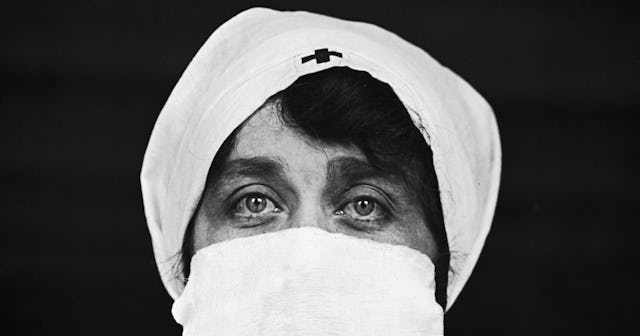When It Comes To The Pandemic, History Is Repeating Itself

Back in March, the world shuttered impossibly fast. In an instant, the lives we once knew disappeared. And everything, now, feels off-balance and unstable. Because we’re in unprecedented times.
Or so the commercials from every company ever would have us believe.
The truth is, these times aren’t exactly unprecedented. A virus has circled the globe and left a staggering death toll in its wake before. People have protested the use of masks in defiance of public health recommendations in the past. Cities have prematurely opened and suffered the consequences of that premature opening. Schools have shuttered. Children have been quarantined. The world has before waited with bated breath for a light at the end of a dark tunnel.
In 1918, a deadly flu circled the globe. All told, 500 million people around the world were infected, and more than 50 million people died. About 675,000 of those deaths occurred in the United States. In an effort to stop the spread of this deadly flu, which unlike COVID-19 targeted younger individuals more severely than older, governments closed down bars, theaters, restaurants, and schools. Many cities, like San Francisco, instituted mask requirements, which carried fines or short prison terms if not complied with.
The Oakland Municipal Auditorium is being used as a temporary hospital with volunteer nurses from the American Red Cross tending the sick there during the influenza pandemic of 1918, Oakland, California, 1918. Underwood Archives/Getty
Then, like now, these public health efforts to stop the spread of a virus that was killing people were met with resistance. Wearing masks—or not wearing masks—became a political statement. People complained that they couldn’t breathe and that masks were taking away their constitutional rights (to what, is still unclear). And, like now, violence erupted over whether people should wear masks or not. The New York Times told the story of a struggle between an anti-masker and a health inspector that ended in shots fired and bystanders running for cover.
Back then, we also lacked a national response to fighting a virus. Different cities also took different approaches to the pandemic. Philadelphia went ahead with a parade to support the war effort and 600 people died within two weeks of the event. At its worst, 1,700 Philadelphians died in a single day. To contrast, St. Louis, which was led by its health commissioner, shuttered schools and shops and canceled all public gatherings. Residents complained, but they lived. More St. Louis residents survived. The city emerged from the pandemic with one of the lowest excess death rates in the nation.
Quarantine summers aren’t new either. During the polio outbreak in the 1940s, children spent summers at home. Sue Gray, an 84-year-old woman in Chicago, told USA Today about her summers growing up as a child in Kansas City. “[Y]ou couldn’t go to pools, you couldn’t go to the movies, you just stayed home.”
Red Cross volunteers fighting against the spanish flu epidemy in United States in 1918. Apic/Getty
The 1918 flu pandemic did eventually end in 1920 as herd immunity was reached. The human cost was high. Fifty million lives were lost. Fifty million families were devastated. The number is almost too high to truly comprehend. Likewise, the polio pandemic eventually ceded when a vaccine was discovered. Children could recover their summers. The instability and terror ended. The normal routines of life returned.
One of the best (saddest?) memes to have crossed my social media feed during the last few weeks is the one that laments the truth about human nature. It says: “We’re gonna have to retire the expression ‘avoid it like the plague’ because it turns out humans do not do that.”
But the truth is, that’s not news. We learned that sad truth almost a century ago.
I don’t know if the fact that history is so closely repeating itself gives me hope that things will be okay, or heartbreak that we haven’t learned by now. Maybe both.
Circa 1918. Paul Thompson/FPG/Getty
There’s something almost eerie in hearing the arguments of folks from more than a century ago echoed in our modern day streets. We should know better now, shouldn’t we? We should know that wearing a mask, suffering a touch of discomfort to protect each other, and ourselves, isn’t the government’s attempt to snatch away a constitutional right. There’s something almost discouraging to read stories about the terrible price paid in the form of 600 lives after the parade in Philadelphia, and then to read the stories of political rallies where social distancing and masks aren’t required. Shouldn’t we have learned a lesson? And there’s something heartbreaking to know that the answer is we should have learned, but we didn’t. As a society, we didn’t learn the hard won lessons of a century earlier.
And yet, it gives me hope to know there will be a light at the end of the tunnel. Things will feel safe again. There will be routines and stability. Eventually. History leads me to believe that’s true. (But I hope with all the hope in my heart that we get that stability via a vaccine and not because we’ve allowed so many millions to die in order to reach herd immunity.)
And I have to hope that maybe this time, this pandemic, will be the one that finally teaches us the lesson. And maybe another generation will learn from our mistakes.
This article was originally published on